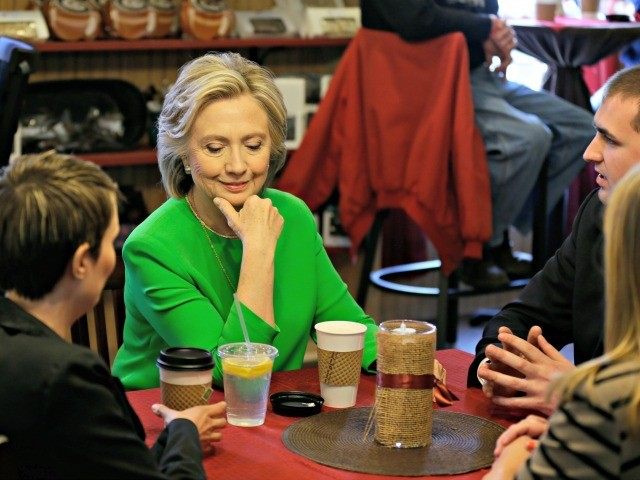The first fundraising numbers for Hillary Clinton’s White House bid will not be posted until July, but Wall Street took leadership roles in fundraising for both of her New York Senate campaigns, and nine of Mrs. Clinton’s top 20 donor organizations in her 2008 presidential bid were financial services firms. But after six years of a Wall Street donation boycott in retaliation for passing Dodd-Frank, Clinton is the Democrats’ best hope for reviving access to $100s of millions from Wall Street’s firehose of political donations.
Wall Street was reliably bipartisan from 1985 to 2010, according to the Open Secrets.org blog. Their number one philosophical criteria for financial donations seemed to be backing elected incumbents. They would secondarily triangulate between the left and the right to stay financially aligned with the party holding the most power.
Citicorp was number one, and Goldman Sachs was the number four contributor to Clinton’s 2000 Senate campaign. Six years later, Citicorp and Goldman Sachs were the top two contributors to Hillary’s reelection campaign. Furthermore, six of the top ten organizations that gave to her campaign and leadership PAC between 2001 and 2006 were from banks, investment firms, and insurance companies.
Clinton’s strong ties with Wall Street were evident in her first run for the presidency in 2008. Goldman Sachs, JP Morgan, and the now-bankrupt Lehman Brothers led a gaggle of banks and their lawyers as Hillary Clinton’s third-largest source of campaign cash. Financial service industry contributions were far ahead of the cash Clinton raked in from donors tied to public education and women’s issues.
After Barack Obama won the 2008 nomination, the future president tripled the level of fundraising by any presidential candidate to $745 million. An enthusiastic Goldman Sachs was his second-largest Obama contributor, and 8 of the 20 largest contributors to the future president were Wall Street banks and law firms.
But all this go-with-the-winner contribution strategy ended in 2010, after a Democrat Congress single-handedly passed and a Democrat president signed the Dodd-Frank Wall Street Reform and Consumer Protection Act. The legislation drastically constrained very profitable securities trading by banks and severely limited their executive’s compensation.
Cash from Wall Street commercial banks, brokers, and their lawyers took a hard pivot away from Democrats in the late 2010 election cycle as Democrats fought Republicans to prevent repeal of the Dodd-Frank Act passed that summer. Despite Democrat control of Congress, Wall Street gave 51 percent of its money to Republicans in 2010, up 9 percentage points from 2008.
With Obama on the ballot in 2012, over two-thirds of Wall Street’s campaign cash was steered toward Republicans, giving conservative candidates an $84.2 million advantage over Democrat incumbents.
Two years later, the 20 organizations whose employees contributed the most to Obama’s 2012 reelection campaign included only one company somewhat related to financial services–accounting and consulting firm Deloitte LLP. Republicans maintained a 61 percent campaign cash advantage with Wall Street that amounted to a $30 million advantage over the Democrats.
One of the Democrats’ most enduring friends on Wall Street, regardless of which party is in power, has been JPMorgan Chase. But after donating $3.9 million to Democrats in the 2008 presidential cycle, the bank only gave Democrats $973,000 in 2010, the lowest total since 1998. JPMorgan donors did double their contributions in 2012 to $1.8 million, but that was only half of the bulge-bracket bank’s political generosity in 2008.
Whether Wall Street donors come back to the Democratic Party has a lot to do with what policies Hillary Clinton runs on. In the past, she was able to get elected on a “listening tour.” She spent two days this week traveling across Iowa to listen to the concerns of highly staged small group coffees with party activists.
But as Breitbart published in “The Real Elizabeth Warren Stands Up to Trash Wall Street,” Clinton’s folksy message was drowned out by the insurgent political threat launched by Senator Warren, who emboldened the extreme leftist wing of the Party to demand that real Democrats pile on more Dodd-Frank punitive regulations against Wall Street.
Clinton defensively replied at one of her coffees, “It’s fair to say that if you look across the country, the deck is still stacked in favor of those already at the top.” She added. “There’s something wrong when hedge fund managers pay lower tax rates than nurses or the truckers I saw on I-80 as I drove here the past few days.”
This type of populist rhetoric is an anathema to Wall Street, who is expected to continue to be the number one or two top source of political action committee cash, following the U.S. Supreme Court overturning PAC contribution limits in the Citizen United case. Total PAC contributions amounted to $96.8 million in 2012 and $78.9 million in 2014. But as of April 2015, 1,360 “Super PACs” already have $350.9 million available for 2016.
The Clinton campaign expects to raise $2.5 billion from supporters and outside “super PACs” for her presidential bid. Although Mrs. Clinton and the Democrat establishment had hoped Wall Street would contribute up to $250 million as a leader in this effort, that “money bomb” will evaporate if Democrats continue “trash talking” Wall Street.

COMMENTS
Please let us know if you're having issues with commenting.